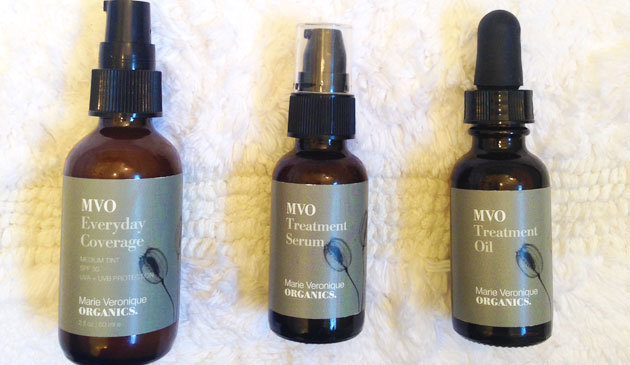Acne-prone. Pimples. Bad skin. Breakouts. Cysts. Spots. Painful. Foundation. Concealer. Embarrassed.
I’ve suffered from embarrassing acne flare-ups since I was 15 years old. Over the years I tried nearly every product marketed towards blemished-faced kids, young adults, and then, ultimately, those that claim to treat both fine lines, wrinkles, and acne, all in one. Nothing ever truly worked – and it wasn’t until I was in my mid-30’s, still agonizing over spot after spot that I decided to abandon everything I’d been told, and try ‘alternative’ treatments, aka – non-toxic products, and take a deeper look at my diet… you know, real wild and outlandish, counter-culture stuff.
Eureka! I started seeing a difference. I tried living without dairy and saw an immediate decrease in my outbreaks. Sugar was much more difficult for me to cut out, but when I did, I saw a marked change. I played around with different herbs, acupuncture, and treating my blemishes with oil, instead of harsh drying toners and lotions, and my little daily outbreaks – as well as the intensely painful monthly ones – diminished.
One day I tweeted an SOS to the green beauty industry. Someone had to be able to help me understand and treat the outbreaks that were still happening. I hadn’t quite gotten it thoroughly under control – and it only made it worse that I was a makeup artist who felt the need to try every face oil and cream that was sent to me. My skin was confused and so was I.
Much to my amazement, I received the most kind response from a well-established aesthetician, Marie Veronique Nadeau. She, along with her physicist and bio-medical engineer-trained daughter, Jay, had created a family of skincare products, with one line focusing solely on healing and treating acne the all-natural way. We had an hour long phone call and the next day she sent me a care package. I was hooked.
Below you’ll find the first part of a series I’ll run on this blog, written by the very intelligent Marie Veronique, offering all of the great info she first shared with me. It’s some pretty heady stuff, so please do as I did, and reread it a few times if you suffer from acne. It’s the framework from which I came to understand that I’d been treating my skin incorrectly throughout the years. We are complicated organisms, and all of our many parts play a role in the health of our skin. In my next post, I’ll share with you Marie Veronique’s top do’s and dont’s for treating your acne.
The Human Skin Microbiome and Acne: Part One
Probably most of us remember being in elementary school and writing addresses that anchored our place in the perplexing cosmological vastness with some variant of: name, street address, city, state, country, continent, planet, solar system, galaxy, universe. Now we have expanded our anthropocentric worldview microscopically as well as cosmically. It turns out we are our microbes to a greater extent than we are our human cells—in fact microscopic life forms outnumber our own cells by about 10 to 1.
This has huge implications for skin owners. Skin is one of the human body’s major ecosystems, home to a vast number of assorted microorganisms. It’s 1.8 square meters of diverse habitats populated by bacteria, viruses, fungi—and even mites. The skin is home to one trillion or 1012 microbes, of 1000 or so different species.
Hosting all this teeming life is a huge responsibility when you come to think of it, but being human we take it for granted—until something goes wrong. As long as our mostly mutualistic microorganisms are protecting us against invasion by more pathogenic organisms, we can go about our business. But at the first sign of something amiss like acne vulgaris, adult acne or rosacea, we’re there with the big guns—quite prepared to nuke the dermal landscape. Our weapons: antimicrobials like triclosan or benzoyl peroxide or antibiotics like clindamycin, doxycycline, erythromycin or tetracycline.
Now that we know antibiotics can disrupt the gut microbiome to the detriment of our health, we’re ready to take a seriously different approach to using antibiotics. We use them only when absolutely necessary. Meanwhile, we can add probiotics and prebiotics to our diet to help keep microbiota populations in balance.
It’s time we exercised the same caution with our skin microbiome, and for the same reason. By massacring every microorganism in the landscape—good, bad or indifferent—we disrupt the balance of the skin’s microflora. The ultimate outcome makes things worse rather than better, at least in the long term. We may not know as much about skin flora as we know about the gut, but there’s sufficient evidence to suggest that effective alternatives to treating common skin conditions like acne do exist. These are peaceful solutions that work without committing mass slaughter or doing long-term damage to your skin’s ecosystem. The trillion-plus microorganisms inhabiting each individual’s skin want it to thrive, and we humans who share it with them do too. Indeed, acne may be a kind of distress signal sent out by a committee of microbes to alert us to something not quite right. Let’s see if we can respond in a way that satisfies everyone. Just imagine—some of our simple solutions may end up improving trillions of lives. And make us humans happier in the bargain.
Thank you, Marie Veronique! You can find her full range of acne-focused products here. I used that line for quite some time as my own skin microbiome was being sorted out – before graduating to this collection. Additionally, I get monthly facials from Jenette Serins, and have found solace in her fantastic skincare products that treat breakout-prone skin, as well.
Comments Off on Acne-prone. Pimples. Bad skin. Breakouts. Cysts. Spots. Painful. Foundation. Concealer. Embarrassed. | ...It's your body




